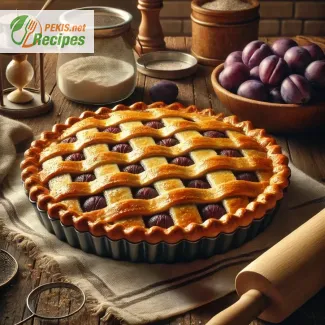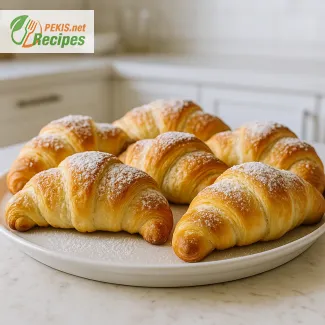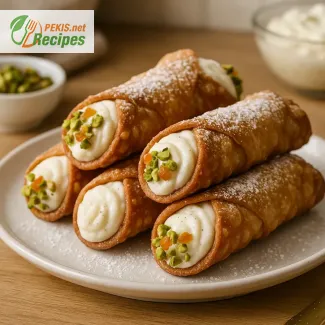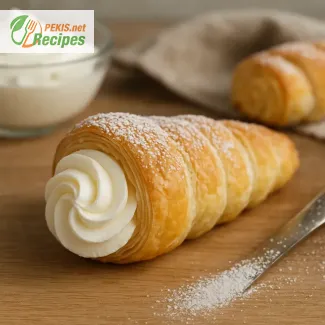
Plum pie with a buttery crust is the epitome of autumnal indulgence, capturing the essence of the season in each delightful bite. As the leaves turn golden and the air gains a crisp chill, few things are as satisfying as a warm, fragrant slice of this rustic dessert. The deep, tangy sweetness of plums mingles with subtle hints of cinnamon and nutmeg, creating a flavor profile that is both comforting and complex. A buttery crust encases the filling, providing a flaky, melt-in-the-mouth texture that is irresistibly rich and pairs beautifully with the vibrant fruitiness of the plums.
An Irresistible Balance of Flavors and Textures
What makes this plum pie truly exceptional is the balance between tartness and sweetness. Unlike overly sweet desserts, this pie allows the natural taste of the plums to shine through, highlighting their slightly sour edge. When baked, plums soften into a luscious, almost jam-like consistency, intensifying their natural flavors and creating a juicy, syrupy filling. This filling, when paired with a golden, crisp crust, delivers a satisfying contrast in each bite, making this dessert a true sensory delight.
The Perfect Dessert for Any Occasion
Though especially fitting for the autumn season, this pie is versatile enough to be enjoyed year-round. Its simple yet refined appearance makes it a wonderful choice for both casual gatherings and elegant dinners. Serve it warm with a scoop of vanilla ice cream or a dollop of whipped cream for added luxury, and watch as it becomes the centerpiece of your table. The aromatic spices, combined with the deep fruitiness of the plums, evoke a sense of warmth and coziness, making it ideal for celebrations, family meals, or simply as a comforting treat to enjoy with a hot cup of tea.
A Tradition Worth Savoring
In many parts of the world, plum pie is cherished as a traditional dessert, symbolizing the harvest season and the abundance of fall fruits. By incorporating local, seasonal plums, this dessert also brings a sense of sustainability and freshness to the table. The use of fresh ingredients not only enhances the flavor but also celebrates the fleeting beauty of plum season, inviting you to savor every mouthful before it’s gone.
A Buttery Crust that Elevates the Experience
The buttery crust in this plum pie is more than just a supporting element; it’s an essential part of the dish’s character. Made with a blend of butter and flour, this crust achieves a texture that’s both tender and flaky, contrasting perfectly with the filling’s softness. The butter’s rich flavor infuses every layer, adding a touch of luxury that complements the plum filling without overpowering it. As it bakes, the crust turns a beautiful golden brown, adding a visual appeal that makes the pie as delightful to look at as it is to eat.
Nutritional Benefits of Plums
Beyond its indulgent appeal, this dessert also offers some surprising health benefits thanks to its main ingredient: plums. Plums are packed with vitamin C, fiber, and antioxidants, which can help support immunity, digestive health, and overall wellness. With each slice, you’re not only treating yourself to a delicious dessert but also benefiting from the nutrients plums bring to the table.
A Recipe Rooted in Tradition and Perfected for Today’s Palates
Plum pie with a buttery crust is more than just a dessert—it’s a culinary celebration of autumn and a testament to the simple joys of seasonal baking. Its timeless appeal lies in the way it brings together classic flavors and textures in perfect harmony, making it an ideal choice for anyone seeking a comforting, homemade treat that resonates with the cozy essence of fall.
Whether you’re a long-time lover of fruit pies or looking to try something new, plum pie with a buttery crust promises to deliver a memorable experience with every bite.
1. Prepare the Crust:
- In a large mixing bowl, combine flour and salt.
- Add cold butter cubes and, using a pastry cutter or your fingertips, blend until the mixture resembles coarse crumbs.
- Gradually add ice water, mixing until the dough just comes together. Avoid over-mixing.
- Divide the dough into two balls, flatten into disks, wrap in plastic wrap, and refrigerate for at least 30 minutes.
2. Prepare the Filling:
- In a mixing bowl, combine plum slices, granulated sugar, brown sugar, cornstarch, vanilla extract, cinnamon, nutmeg, and lemon juice. Stir gently to coat plums evenly.
- Let the filling sit for 10 minutes to allow the flavors to meld.
3. Roll and Shape the Dough:
- Preheat the oven to 200°C (400°F). Grease a 23 cm (9-inch) pie dish.
- Roll out one dough disk on a floured surface to a 30 cm (12-inch) circle. Gently press the dough into the pie dish, trimming any excess.
- Spoon the plum filling into the crust, spreading it evenly.
4. Top the Pie:
- Roll out the second dough disk to the same size and place it over the filling. Trim the edges and crimp to seal.
- Cut slits in the top crust to allow steam to escape.
- Brush the top with egg wash for a golden finish.
5. Bake the Pie:
- Bake in the preheated oven for 45-50 minutes or until the crust is golden and the filling is bubbling.
- Let the pie cool for 1 hour before slicing.
When creating a plum pie with a buttery crust, there are several tips and variations you can apply to customize, enhance, and adapt this recipe for your specific needs. Whether you’re looking to adjust for dietary restrictions, experiment with different flavors or textures, or simply improve your baking techniques, here’s a comprehensive guide to refining and personalizing this autumn dessert.
1. Customizing the Crust for Flavor and Texture
Achieving the Perfect Flaky Texture
- Use Cold Ingredients: The key to a flaky crust lies in keeping the butter and water cold throughout the mixing process. Cold butter creates pockets within the dough, resulting in a light, crisp texture when baked. Chill your flour, or even the mixing bowl, in advance to maintain this cold environment.
- Mixing Method: Use a pastry cutter or fork to incorporate butter into the flour until it resembles coarse crumbs. Avoid over-mixing, as too much handling can cause the dough to become tough rather than tender.
Experimenting with Alternative Fats
- Swap Butter for Shortening or Lard: For an extra flaky crust, consider using lard or a combination of butter and shortening. While butter provides a rich flavor, lard contributes a lighter, flakier consistency. If using shortening, keep it cold to mimic butter’s effects on flakiness.
- Adding Sour Cream or Yogurt: For added tang and tenderness, try incorporating a few tablespoons of sour cream or yogurt into the dough. This approach will add a subtle flavor that complements the plums while increasing the moisture content.
Enhancing the Flavor of the Crust
- Incorporate Spices: Add a hint of cinnamon, nutmeg, or even ground ginger to the crust dough for a warm, spiced flavor that pairs beautifully with the plum filling.
- Use Almond Flour: Substitute a portion (up to 20%) of the all-purpose flour with almond flour for a nuttier taste and added richness. This adaptation works especially well with plum pie, as almonds and plums have a natural flavor affinity.
2. Optimizing the Plum Filling
Selecting and Preparing the Plums
- Choose the Right Type of Plum: Depending on your desired flavor profile, select either European-style plums for a deeper, sweeter taste or Japanese plums for a juicier, more tart filling. Firm, ripe plums work best, as they retain their shape during baking.
- Balance Sweetness and Tartness: Taste your plums before using them. If they are very sweet, reduce the sugar slightly. If they’re more tart, add a little extra sugar or honey to enhance the filling’s sweetness.
Thickening the Filling
- Use Cornstarch or Arrowroot Powder: Cornstarch is a common thickener in pie fillings. For a slightly clearer consistency, arrowroot powder works well as an alternative. Adjust the amount based on your preference; for a thicker filling, use an extra tablespoon.
- Enhance with Apples or Pears: For added texture and natural sweetness, mix in diced apples or pears with the plums. This combination adds depth to the filling, offering a mild sweetness that enhances the overall flavor without overpowering the plums.
Adding Complexity with Spices and Aromatics
- Experiment with Spice Blends: Besides cinnamon and nutmeg, try adding ground cloves, allspice, or even cardamom to the filling for a rich, aromatic effect. These spices enhance the plum’s natural flavors, creating a warm, comforting profile perfect for autumn.
- Vanilla and Citrus Zest: A splash of vanilla extract or a hint of lemon or orange zest can brighten the filling. Citrus zest adds freshness, balancing the sweetness and providing a subtle contrast to the earthy spices.
3. Dietary Adjustments and Allergen Substitutions
Making the Recipe Gluten-Free
- Substitute Gluten-Free Flour: Use a 1:1 gluten-free baking mix to replace the all-purpose flour in both the crust and filling. Ensure your flour blend contains xanthan gum or a similar binder to maintain structure.
- Almond Flour and Coconut Flour Blend: For a gluten-free option with a nutty flavor, blend almond flour and coconut flour. This combination works well with plums but may require slightly more binding agent, such as an egg or a tablespoon of flaxseed meal.
Creating a Dairy-Free Crust
- Replace Butter with Coconut Oil or Margarine: For a dairy-free crust, substitute cold coconut oil or a high-quality dairy-free margarine. Both options will provide a flaky texture, though coconut oil may impart a subtle coconut flavor.
- Use a Nut Milk Wash: Instead of egg wash, brush the crust with almond milk mixed with a teaspoon of maple syrup. This will give a golden, slightly caramelized finish without dairy.
Reducing Sugar Content
- Natural Sweeteners: Replace sugar with natural sweeteners like honey, maple syrup, or coconut sugar. Be mindful of the ratios, as liquid sweeteners may alter the filling’s consistency.
- Sugar-Free Option: For a lower glycemic option, try erythritol or monk fruit sweeteners. These alternatives won’t affect the pie’s texture but will reduce overall sweetness, so adjust based on taste.
4. Enhancing Presentation and Baking Techniques
Improving Crust Presentation
- Decorative Edging: Try different crimping techniques or use a fork to create a pattern around the pie’s edges. For a lattice or braided crust, roll out dough strips and weave them over the filling to create a visually stunning effect.
- Brushing with Egg or Milk Wash: An egg wash creates a shiny, golden finish, while a milk wash adds a softer, matte look. For a sweet finish, sprinkle the crust with a bit of coarse sugar after brushing with the wash.
Baking and Serving Tips
- Blind Baking for a Crisp Crust: If you prefer a crisper bottom crust, consider blind baking. Pre-bake the crust for 10–15 minutes with pie weights to avoid sogginess, then add the filling and finish baking.
- Resting the Pie Before Serving: After baking, let the pie cool for at least an hour. This cooling period allows the filling to set, making it easier to slice cleanly and serve.
5. Nutritional Enhancements and Health Benefits
Boosting Fiber Content
- Add Whole Grains: Use a portion of whole wheat flour in the crust to increase fiber content and create a heartier texture. Whole grains add a subtle nuttiness that complements the plums.
- Include Flax or Chia Seeds: For added omega-3s and fiber, mix a tablespoon of ground flaxseed or chia seeds into the filling. These seeds absorb moisture, helping thicken the filling naturally.
Increasing Antioxidants
- Dark Fruits for Added Color and Nutrients: Mix in a few dark cherries or blueberries with the plums for a filling that’s richer in antioxidants. These fruits pair well with plums and contribute to the pie’s vibrant color and health benefits.
- Honey or Maple Syrup for Sweetness: Using honey or maple syrup instead of refined sugar adds trace antioxidants and minerals like zinc and magnesium.
Crafting the Perfect Plum Pie
With these adjustments and techniques, you can create a plum pie tailored to your preferences and dietary needs. From experimenting with different spices and textures to exploring allergen-free alternatives, this pie offers versatility that goes beyond a standard recipe. Each adjustment contributes something unique, whether it’s a health benefit, an enhanced flavor, or an improvement in texture. Above all, remember to enjoy the process, savoring the seasonal essence and warmth this dessert brings to your table.
- Contains gluten, dairy, and eggs.
- For gluten-free: Replace all-purpose flour with a gluten-free baking mix.
- For dairy-free: Use a dairy-free butter substitute.
- For egg-free: Skip the egg wash or use plant-based milk with a touch of maple syrup for browning.
- Vitamin C (6 mg): Boosts immune health.
- Vitamin K (10 mcg): Supports blood clotting and bone health.
- Potassium (160 mg): Helps regulate blood pressure.
- Polyphenols (30 mg): Reduces inflammation and oxidative stress.
- Anthocyanins (10 mg): Supports cardiovascular health and reduces oxidative damage.





